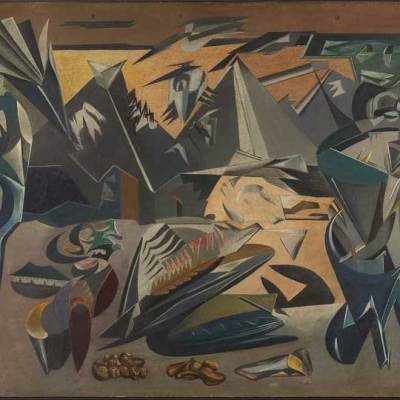The painter Sidney Nolan was born in a Melbourne suburb 100 years ago in April. A rich programme of events has been planned in the UK to mark the artist’s centenary year. There are to be four exhibitions of Nolan’s works at Pallant House Gallery in Chichester, Birmingham’s Ikon Gallery, and in London, at Australia House and the British Museum. In March the Menzies Centre of Australian Studies at King’s College London is hosting a symposium on ‘Nolan in Britain’; in April there will be another symposium on the artist at the Royal Academy; and in May, the studio at Nolan’s final home in Herefordshire (The Rodd) will be opened to the public for the first time.
No comparable fanfare has been sounded here in Australia, though I doubt this is on purpose. Melbourne’s Heide Museum of Modern Art plans to mount in its library its only Ned Kelly painting and some archival material; there’s talk of a ‘keynote lecture’ and a minor rehang here in Sydney at the Art Gallery of New South Wales; and, when I made enquiries, I was told that the director of one state art gallery had recently been seen in the library with a Nolan catalogue. A private citizen has taken matters into his own hands by mounting a website where centenary events in Australia are to be posted as they are announced; none yet. To fill the void, the website owner proposes the outline of a phantom centenary publication – we have the cover but not the contents – taking its title, Imagining in Excited Reverie, from Yeats.
Nolan famously kept a focus on Australia, and on specifically Australian subject matter, even after he made his home in England in the early 1950s (permanently, as it turned out); no doubt this will be discussed in the London symposiums. ‘All those Australian paintings that I’ve done since 1948 were done in Europe,’ he told an interviewer in 1982. ‘I can evoke it at will amongst the snow in Wales and paint the Australian bush.’ Like Marlowe in Conrad’s Heart of Darkness, haunted by the Congo in Brussels, Nolan saw Uluru in the façade of the Houses of Parliament and the Murray River in the Thames. It was the contemplation of elsewhere that sharpened up his homeland imagery. His many travels tended to bring him back to it. Painting Africa, for instance, was described by Nolan as ‘a kind of dry run for a further attempt on the Australian continent’.
Thames (1962), Sidney Nolan. © Sidney Nolan Trust

As his supporter Kenneth Clark recognised, Nolan managed to turn Australia into something allegorical, something symbolically central rather than geographically marginal. The psychological and environmental effects of the colonial enterprise here were not just part of a local story, they rehearsed the trajectory of Western civilisation as a whole. The fact that these effects are played out in Australia on an ‘open and floodlit’ landscape, as Nolan pointed out, makes them more visible, and so – he might have added – more available to dreams and to the image maker. The poignancy of a funfair against a vast blue sky; a convict figure, up to his waist in an indifferent river; a tree burning in a desert, observed by men in uniforms whose signifying purpose is somehow rendered utterly absurd. In such images the specifically Australian scene becomes tragic, universal.
In 1970 Nolan accompanied Benjamin Britten on a trip round Australia. At Green Island near Cairns they went down in a big tank with glass windows to view the Great Barrier Reef. The painter and the composer looked out in wonder at ‘this extraordinary display of fishes and sponges and clam and coral and this kind of growth, all these odd forms, all this colour and all this display, and all these mysterious reasons why evolution has made some fish striped and things’. The beautiful reef is now of course the focus of international concern, the victim of rising sea temperatures, although the mining industry and our government would prefer us not to notice, and tourists are told that sunscreen from swimmers is to blame for the unsightly bleaching. Suddenly this seems a very Nolan-ish sort of an image.
From the January issue of Apollo. Preview and subscribe here.


